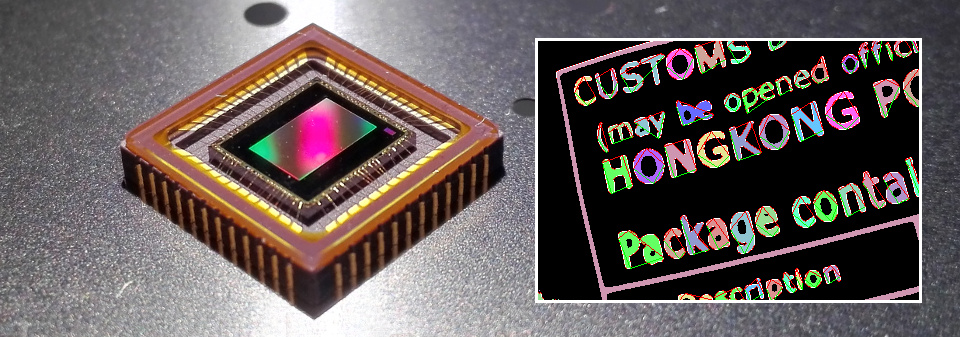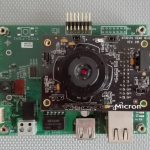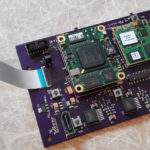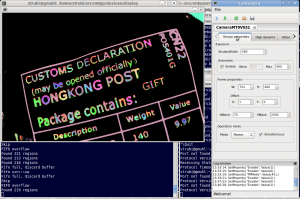The ECP5 platform has caught quite some attention a while ago, being on the rather high end with respect to GigaBit LVDS communication of all sorts. It’s the successor of the ECP3 which has been performing well with HDMI applications in the past.
Lattice Semiconductor had launched a Promo action for this Versa ECP5G board. With great assistance from Future Electronics Switzerland I was able to get hold of a devkit.
Running the Lattice Diamond toolchain on a Linux environment has so far been straightforward, with minor quirks on the GUI side. Let me revisit the important items to get up and running. If you happen to have a Linux OS installed that does not match the Lattice Semi recommendations for a development system, you might want to look at the Docker approach on how to set up the environment.
Programmer preparation
Porting a very simple CPU with UART interface to the platform, the final step is flashing things down into the board using the Lattice Diamond Programmer. Usually, when not having installed any udev rules, these are the steps you have to go through with root powers, in order to get the USB FTDI programmer interface recognized:
Bus 001 Device 013: ID 0403:6010 Future Technology Devices International, Ltd FT2232C Dual USB-UART/FIFO IC
According to this device enumeration, you give access to the device:
chmod a+rw /dev/bus/usb/001/013
and unbind the first ttyUSB0 device from the ftdi_sio driver – unfortunately, the Lattice driver is not able to unbind from within.
echo -n $TTY_ID > /sys/bus/usb/drivers/ftdi_sio/unbind
Replace $TTY_ID by the tty device entry in /sys/bus/usb/drivers/ftdi_sio/ that typically is of the form “1-3.2:1.0” (the trailing 0 stands for port A where the JTAG is at). If you have plugged in more than one FTDI adapter with UART capabilities, you will see several and need to figure out which is which.
Now you can download code into the programmer.
To automatize the process, you could also use the script below:
#/bin/bash allow_io=`lsusb | sed -n 's/^Bus \([0-9]*\) Device \([0-9]*\): ID 0403:6010 .*/\1\/\2/p'` unbind_tty=`ls /sys/bus/usb/drivers/ftdi_sio/ | sed -n 's/\(.*\:1\.0\).*/\1/p'` sudo chmod a+rw \/dev\/bus\/usb\/$allow_io sudo sh -c "echo $unbind_tty > /sys/bus/usb/drivers/ftdi_sio/unbind"
SPI flash download
When downloading your design into the SPI flash, make sure you have MASTER_SPI_PORT=ENABLED set in your *.lpf file. Otherwise the programmer will fail with an error report on CHECK_ID:
ERROR - Verification Error...when Processing function: 'CHECK_ID'
Then you’ll have to use the fast download (into SRAM) with an enabled Master SPI in order to be able to flash again.
Design issues
When starting to port our SoC design to this board, quite a few issues came up:
- Don’t bother developing with Diamond v3.7. Some very obscure behaviour with wrong I/O mapping cost quite some headache. Seems to be solved in v3.8
- v3.8 however is somewhat misleading with respect to output and return states from the Synopsys Synthesis engine ‘Synplify’. Make sure to check your design thoroughly, if Synplify throws an error, Diamond sometimes would not recognize that and map/PAR an old design netlist.
- Weird random behaviour can occur under Linux with Diamond during PAR, like error messages with respect to path names. This seems to happen especially with long names and underscores. The behaviour has been around in many previous versions of Diamond, Tech Support has refused to accept this as a bug so far. The workaround is to call PAR using the command line (TCL) or use the Run Manager.
Addendum: It seems that this bug is fixed in v3.9, but there is no release note about it.
Talking through the UART
In theory, you should be able to talk to your design through the UART (if your design supports it) by firing up minicom:
minicom -o -D /dev/ttyUSB1
Now here comes the catch: The default EEPROM from my Versa 5G board did not have a correct descriptor, however it came with the default VID:PID from FTDI, so the ftdi_sio driver would recognize it, but in fact not communicate, neither report an error.
So, in order to properly use this board, you may have to erase the EEPROM of the FTDI adapter on the Versa kit using FTDIs Mprog tool or alike. You might want to save the previous EEPROM content for reference, however it does not seem needed, the Programmer recognizes the Board just fine.
Finally, after downloading our SoC setup into the board, it is talking:
Booting, HW rev: 04 -- Running at 50 MHZ ------------- test shell ------------- -- ZpuSoC for Versa ECP5 -- -- (c) 2017 www.section5.ch -- -- type 'h' for help -- #
Simulation issues
When trying to fully simulate the SoC setup with PLL primitives and some instanced ip cores created by the Clarity module (obviously that’s the IPExpress descendant for ECP5), it turns out that some of the simulation primitives for the VHDL side are missing.
Some of them could be converted using the VHDL conversion trick from Icarus Verilog by the following Makefile rule:
%.vhdl: %.v
iverilog -tvhdl -o $@ -pdepth=1 $<
However, some of the needed components might not convert without additional tweaking. Hopefully, Lattice Semi will come out with updated VHDL libraries.
IPcore simulation under GHDL
When generating IP cores that depend on library items and running them through GHDL, you might see this error message:
warning: component instance "scuba_vlo_inst" is not bound
However, if you have prepared your FPGA primitive components library, like ecp5um-obj93.cf right, the primitive simulation models should be in there (search for ‘vlo’ in the *.cf file if in doubt).
The reason why this is happening is that there could be component prototype declarations in the IP core file that shouldn’t be there in order to reference to the components from the library. So: Just remove the “component” declaration sections and all should link fine. The drawback of this is, that you need two IP core versions, one for simulation and one for synthesis. If you have a better solution, let me know.
Next steps
Now, the fancy stuff on this board to be evaluated is:
- DDR3 memory
- Two GigE capable interfaces
Also, the ECP5 on this board has enough resources to run several ZPUng cores simultaneously. For safety reasons, we wouldn’t want the IoT crap run in the same environment as our controlling main loop.
Therefore, a second processor (Core B) is instanced for running the Ethernet Stack (lwip) only, while maintaining a simple DMA channel to the controller Core A for communication. If core B is compromised, Core A will still maintain its “hardened” control loop and not go haywire.
Implementing DDR3 is tricky. Therefore you might want to use the DDR3 IP core supplied by Lattice. On the demo kit, it will work for a few hours and then pull the global reset.
Networking
Of course, I was very curious about the Ethernet ports on this board. It’s armed with two GigE capable Marvell Phys whose data sheets are a little hard to get hold of, but one might also look at various source code around the web or just check the reference design from Lattice. The reference design uses lwip, since I only need and want UDP, I ported a zerocopy-capable UDP stack I developed for the Blackfin EMAC to the ZPUng SoC (“cranach”), which is equipped with some DMA capable scratch pad memory for a proper packet queue.
After all, the FPGA is now able to speak netpp, so I can turn on an LED for example:
> netpp UDP:192.168.05:2016 LED.Yellow 1
Resource usage
You might want to know how much logic and RAM is consumed by this solution.
Design Summary Number of registers: 2770 out of 44457 (6%) PFU registers: 2767 out of 43848 (6%) PIO registers: 3 out of 609 (0%) Number of SLICEs: 2963 out of 21924 (14%) SLICEs as Logic/ROM: 2891 out of 21924 (13%) SLICEs as RAM: 72 out of 16443 (0%) SLICEs as Carry: 309 out of 21924 (1%) Number of LUT4s: 4154 out of 43848 (9%) Number of block RAMs: 28 out of 108 (26%) Number of DCS: 1 out of 2 (50%) Number of PLLs: 1 out of 4 (25%)
As for the actual program code, containing:
- UDP stack supporting ARP, ICMP ping
- Minimal shell (UART)
- System I/O drivers (UART, Timer, MAC, PWM)
- netpp minimal server with some LED handling
This is what’s effectively downloaded into the target:
(gdb) init Loading section .fixed_vectors, size 0x400 lma 0x0 Loading section .l1.text, size 0x4af5 lma 0x400 Loading section .rodata, size 0x168 lma 0x4ef8 Loading section .rodata.str1.4, size 0xf60 lma 0x5060 Loading section .data, size 0x2c0 lma 0x5fc0 Start address 0x0, load size 25213
There’s a significant amount of string data for debugging in the .rodata.str1.4 section due to debugging info, plus some netpp descriptors. These again could be ‘overlayed’ to the SPI flash, as they are not too frequently accessed. To be investigated next…




